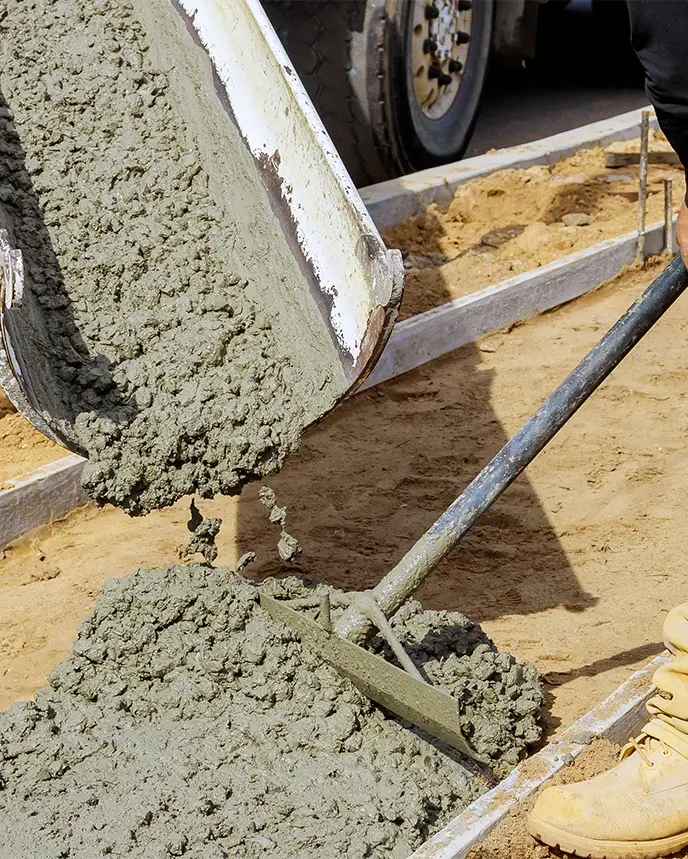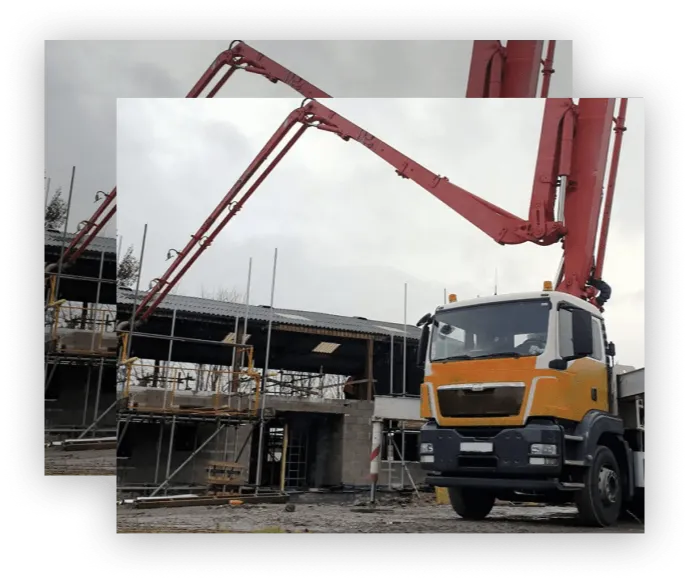Why break a sweat when our experts at Pro-Mix Concrete can pump up your project with our advanced machinery? Our top-tier concrete pump hire service guarantees precise & professional concrete pouring, reaching heights that traditional methods could only imagine.
At Pro-Mix Concrete, we make the highest-quality ready-mix concrete with optimal strength & durability, perfectly tailored to your project & delivered to your site in a timely manner. Our ready-mix concrete is the holy grail ingredient to accomplishing your construction tasks impeccably & efficiently.
Get the best concrete mixed to perfection by our team in front of your eyes! Whether you’re pouring a new patio or building complex architectural details, our experts will arrive at your construction site & prepare an ideal concrete mix with premium components & advanced equipment.
With Pro-Mix Concrete’s floor screed, you can create an immaculate foundation to guarantee an even, flawless surface. With our specialists who bring an excellent balance of technical expertise & a dash of whimsical flair, your floors will be the talk of the town!
Remodel your driveway & backyard with Pro-Mix Concrete’s premium-grade domestic concrete! Just like every construction project, our concrete is also unique. We customize the mixture with great attention to meet your specific requirements that promise a long-lasting & even finish.
TYPES OF CONCRETE


C20 Concrete Mix Ratio
Among the lightweight mixes we handle, GEN3 concrete or C20 mix concrete is the most commonly used. C20 mix finds its application in a variety of projects, particularly on uneven surfaces. It holds a C20 concrete mix ratio strength of 20 newtons after 28 days, and it sees frequent use in residential projects, with potential in select commercial uses as well.
Being a lightweight blend, GEN3 concrete contains the highest cement content compared to other GEN concrete mixes. This characteristic adds to its adaptability, making it an easy-to-handle option suitable for various tasks.
-
Paving pathways and patios
-
Creating bases for sheds and garages
-
Constructing garage floors
-
Making unreinforced strip footings
-
Forming foundations for walls and single-storey structures
-
Crafting internal floor slabs that will be concealed
-
Suitable for both commercial and domestic purposes
However, using C20 mix for the foundations of larger structures, such as extensions or other buildings that demand a sturdier base, is not advisable.
Important: Avoid using concrete externally unless it’s fully covered or enclosed.
Mix Your Own C20 Concrete
For the best concrete mixture, the correct C20 mix ratio is as follows:
-
1 part Cement
-
2 parts Sand (fine aggregate)
-
4 parts Gravel (coarse aggregate)
If using premixed ballast, the concrete C20 mix ratio becomes 6 parts ballast to 1 part cement. For optimal results, water should be around 55 per cent of the cement’s net weight if all materials are perfectly dry. However, materials are often slightly damp, especially sand. In such cases, you might need to adjust the water quantity accordingly.


Get Your C20 Concrete London From Pro-Mix Concrete
Our experts have formulated the C20 mix ratio to cater to a construction project that demands a dependable and high-quality base.
At Pro-Mix Concrete, we’re ready to deliver this C20 grade concrete in the exact quantity you need. We’re committed to ensuring your project starts promptly. Using our volumetric trucks, we provide an on-site mixing service, which means you receive the precise amount of C20 needed for your project. This approach allows you to pay solely for the concrete utilised, leading to cost savings and reduced waste.
If you’re uncertain about whether GEN 3 concrete London suits your needs, don’t hesitate to reach out to our team today. We’re here to offer assistance and guidance.
Understanding C20 Concrete Strength
Concrete strength is gauged in PSI (pounds per square inch) and newtons, reflecting the minimal compressive strength the concrete attains 28 days post-pouring. C20 material registers a PSI of 2900 or 20 newtons after this period, making it an optimal choice for residential tasks that demand a light-duty mixture.
GEN3 Concrete Or C20 Concrete?
C20 material possesses identical GEN3 concrete strength levels. GEN3 concrete stands for General concrete grade 3 and is the same as Grade C20 in terms of strength. The two, GEN3 concrete and C20 mix, signify the same concrete grade. In contrast to other concrete types, a C20 concrete comprises double the amount of cement, whereas a typical on-site mix requires just one part of cement.
Use our specialised concrete mix calculator UK to determine exact ratios for British standards!
Frequently Asked Questions
The C20 concrete label represents the Concrete’s Compression Resistance strength. Specifically, for C20 concrete, this C20 concrete strength measures at 20 N/mm2 per square meter after 28 days.
Concrete comes in various grades with distinct resistances, ranging from C7 to C40. Among these grades, C7 is the least robust, while C40 can endure the highest pressure over an extended period. C20 concrete occupies a middle ground on this scale, making it suitable for both domestic and commercial ventures.
Follow the standard 4:2:1 ratio to determine the necessary concrete amount. Combine four parts of coarse aggregate with two parts of fine aggregate and one part of cement. This formula yields the fundamental composition of C20 concrete. If you’re personally handling the mixing and pouring of C20 concrete, you can adjust the strength and texture as desired. This flexibility is among the advantages of on-site concrete mixing.
Certainly, any concrete can be made sustainable with the right materials. The process is simple. By using recycled aggregates sourced from demolition sites, you can run these materials through an industrial crushing machine. This machine breaks down the rock into a specific grain size tailored to your desired outcome. The crushed stone can even be turned into a fine powder for use as cement. Gravel and coarse aggregate can also be obtained by recycling building materials from demolition projects.
C20 concrete is ideal for lighter foundations and small-scale residential tasks, whereas C30 concrete boasts higher strength. That means the latter is suitable for applications like paving, hard standings, and house extensions, while C20 concrete remains perfect for residential applications requiring proven C20 concrete strength.


